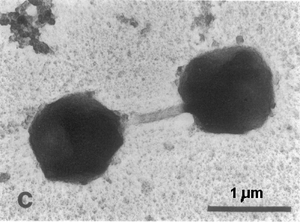Hyperthermus: Difference between revisions
No edit summary |
|||
| Line 10: | Line 10: | ||
===Species=== | ===Species=== | ||
''Hyperthermus butylicus'' | |||
{| | {| | ||
| Line 15: | Line 17: | ||
'''NCBI: [http://www.ncbi.nlm.nih.gov/Taxonomy/Browser/wwwtax.cgi?id=54247 Taxonomy] Genome ''' | '''NCBI: [http://www.ncbi.nlm.nih.gov/Taxonomy/Browser/wwwtax.cgi?id=54247 Taxonomy] Genome ''' | ||
|} | |} | ||
==Description and significance== | ==Description and significance== | ||
Revision as of 18:59, 16 August 2006
A Microbial Biorealm page on the genus Hyperthermus

Classification
Higher order taxa
Archaea; Crenarchaeota; Thermoprotei; Desulfurococcales; Pyrodictiaceae
Species
Hyperthermus butylicus
|
NCBI: Taxonomy Genome |
Description and significance
Hypperthermus is a hyperthermophilic, sulfur reducing archaeon that grows between 95 and 106°C and at pH of 7.0. Also, it forms H2S from elemental sulfur and molecular hydrogen as a growth-stimulating accessory energy source but not by sulfur respiration. Further, the archaeon has a characteristic smell which composes of H2S and butyl mercaptan and the odors of 1-butanol and phenylacetic acid.
Genome structure
The genome of Hyperthermus is currently being sequenced by the group from the University of Copenhagen. The G + C content of the DNA is around 55%.
Cell structure and metabolism
The cells of Hyperthermus are irregular spherical (around 1.5 µm in diameter) shape with edges between partially flattened surfaces. The ones that grow in higher temperature often contain vacuoles within their cytoplasm, sometimes immediately below the S layer. The archaeon utilizes peptide mixtures, obtained by various hydrolysis procedures (eg, Tryptone, Trypticase, Merck peptone from casein, gelatin, and a chymotryptic digest of casein) as carbon and energy sources. No growth has been observed with starch, maltose, sucrose, lactose, glucose, galactose, ribose, lactic acid, lactic acid ethylester, glyoxylate, pyruvate, oxalate, fumarate, maleate, malate, malonate, and formate. Hyperthermus is the first archaebacterium for which fermentation products have been identified. Its H2S formation results in increased growth capacity without a major change in the nature of the products, except that it allows utilization of peptide-bound nitrogen. Therefore, this could possibly act as an accessory means to generate ATP.
Ecology
The strains of Hyperthermus butylicus were isolated from the sea floor of a hot, solfataric babitat on the coast of São Miguel Island in Azores, Portugal. With its ability to live at the temperature of 106°C, it is one of the most thermophilic archaea isolated so far. Also, interestingly, despite its being found in a marine environment,
